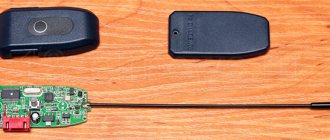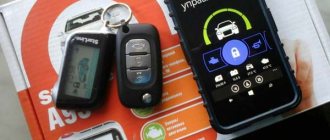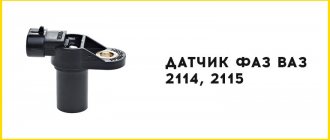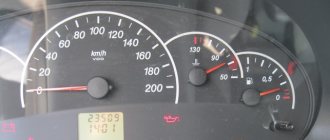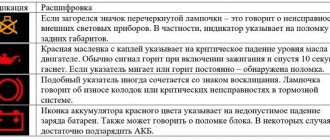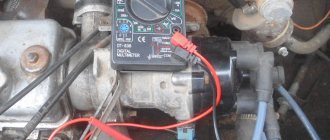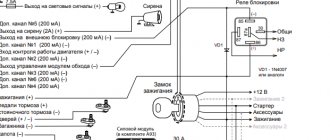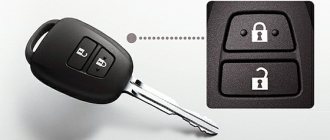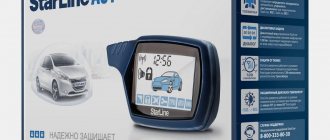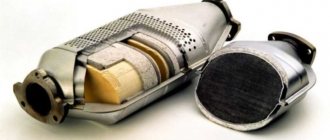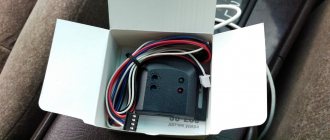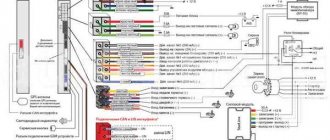usually it is not perceived correctly. Well, a person who is far from all this does not want to believe that it is all due to illiterate installation with a bunch of violations of the laws of physics, electrical engineering, electronics and radio engineering. Like, “It’s so complicated - attaching the signaling to the car!”
Source
How to set up a Starline alarm if it goes off on its own
Most often, random activation of the StarLine alarm is associated with incorrect settings of the shock sensor. The fact is that the name “shock sensor” itself is incorrect - it is a vibration sensor, so it also responds to strong noise, road vibrations from passing trucks, and so on.
- Warning level: as soon as the vibration recorded by the sensor exceeds a preset level, a short-term siren signal is activated, and the corresponding information is supplied to the key fob.
- The alarm level is set higher than the warning level. In this case, the siren turns on constantly, all interlock circuits are activated, and instead of a single signal and short-term vibration, the key fob transmits signals periodically.
A properly configured and installed (this is no less important) shock sensor does not cause serious problems, and occasionally it has to be reconfigured (for example, if construction begins next to the parking lot).
What to do if the alarm does not go off from the key fob
Quite often it can happen that the alarm system does not see the key fob after replacing the battery in it or turning off the power supply to the vehicle's on-board network by removing the battery. This means that there was a memory failure in the security system, as a result of which all key fobs previously registered in it were erased. In this case, it is necessary to restart the process of recording key fobs, which is performed as follows:
- The location of the service button of the security system control unit is located, it is pressed seven times and the car ignition is turned on. After which the system siren will emit seven beeps.
- After this, on the key fob itself, buttons No. 2 and No. 3 on the key fob are simultaneously pressed and held until the moment when the siren in the car and the key fob itself emit one sound signal, which means the end of the recording process in the memory of the control unit. Next, the alarm should begin to fully operate from the key fob buttons.
Starline a91 main keychain
If this does not happen, it means that the key fob itself or the internal parts of its antenna are faulty, which are not capable of transmitting radio waves with the required power. In this case, you need to purchase a new key fob with a display and record it in the memory of the security system device.
Errors when installing the shock sensor
On older generations of StarLine alarms, an external shock sensor was used, which had to be placed in strictly defined places in the car. If it was not installed correctly, it either could not be adjusted adequately, or it would work on its own.
A common mistake is gluing the sensor to the plastic panel from the inside. Even with high-quality preparation, using a branded primer and 3M adhesive tape, it comes unstuck and either falls onto the bottom panel or dangles from its wire.
There is also an equally stupid solution - attaching the sensor with plastic ties to a thick wiring harness (if the alarm is hidden in the area of the mounting block). The sensor is adjusted in a warm box, when the harness is softer and transmits vibration less well, and in winter the wires “dumb”, and the alarm goes off on its own with significantly less vibration than before.
When the shock sensor is rigidly installed on metal brackets rigidly connected to the engine shield, random activations sometimes occur due to the cooling exhaust manifold - short-term vibrations (“clicks”) are transmitted through the cushions to the engine shield, and from it to the bracket.
Video: Setting up the Shock Sensor Alarm.*Avtoservis Nikitin*
The shock sensor itself has different sensitivity depending on the direction of its piezoelectric plate: better it detects vibrations that are directed perpendicular to its plane, worse - parallel to the plane. Therefore, if the sensor is directed to the side and is adjusted by tapping on the windshield, then it has increased sensitivity to vibrations from passing cars - hence the risk of Starline triggering for no reason.
General provisions for setting up the system
The sensitivity of the Starline alarm is adjusted independently. To do this, you need to find a specific position for installing the shock sensor. The instructions state that the manufacturer recommends integrating the recognition system into the base of the steering column. The sensor is equipped with two fine adjustment mechanisms that allow you to adjust the sensitivity. To do this, use a standard Phillips screwdriver. To decrease the indicator, the mechanism turns to the left, and to increase, respectively, to the right.
The reasons for the constant alarm activation are:
- The default alarm sensitivity settings are set to the extreme maximum.
- Poor fixation of the alarm unit and shock sensor. To solve the problem, you need to re-secure them to a hard surface. They should not dangle or hang.
Important: If setting the sensitivity does not help and the control unit is firmly fixed, but the problem of constant alarm operation remains, this indicates that the sensor is broken. You need to contact a service center to replace it.
We reduce the sensitivity of the sensor during autostart
A running motor creates increased vibrations, which are registered by the shock sensor as an alarm, and the alarm may go off during autostart. Therefore, by default, when the alarm is started, the shock sensor is turned off, but this reduces the security of the car - if the glass is broken while the car is warming up in the morning behind the house, the alarm will not go off.
Therefore, it makes sense to activate the shock sensor during autostart, but slightly reduce its sensitivity. To configure the sensitivity of the StarLine A91 or A93 alarm to turn on the sensor during autostart, you need to:
- enter the SF settings menu (we already wrote about how to do this earlier);
- go to function 03, which sets the algorithm for the operation of the shock and tilt sensors when the motor is running;
- set it to the value 03-2 or 03-4: in this case, at the beginning of the autostart cycle, the sensors will turn off, but after the engine has been successfully started, they will turn on again;
- check whether the sensors are triggered when the motor is running, and if necessary, reduce the sensitivity in the settings.
Something else useful for you:
Determining alarm sensitivity and adjusting the sensor
The two-level sensor installed by default in the Starline system operates on the so-called piezo effect. The sound wave reaches the body of the car even before the impact. This is ensured only by tightly fastening the sensor to a metal element directly connected to the body. To adjust the sensitivity, both zones are reduced, but the warning zone located opposite the green indicator is added. After that, the car is set to security mode and after 40 seconds you need to carefully hit the body.
This action will indicate the level of sensitivity - if it is excessive, then it must be reduced. The same procedure is carried out to establish a full alarm zone. The maximum sensitivity indicator of the alarm and warning indicators of the shock sensor corresponds to the value 14. The minimum indicator (coarsening) is 0.1. A value of 0 disables the shock sensor completely.
How to reduce sensitivity
Setting up an external shock sensor
The external shock sensor of the StarLine Twage and Dialog alarm families has two separate controls - compact trimming resistors with heads for a thin flat-head screwdriver.
There is a control LED next to each resistor - if the shock sensor is easy to see during installation, this makes setup easier. The upper trimmer is used to set a warning, the lower one sets the alarm level. If you need to configure it, it’s easier to do this:
1. Turn both trimmers counterclockwise until they stop, setting the sensitivity to minimum. 2. Set the warning sensitivity to a third, close the doors and arm the car. 3. After waiting at least 15 seconds for the alarm to activate the shock sensor, tap the windshield with your knuckles. The blows are sharp, but not strong. 4. If the warning level is sufficient, it will work. Otherwise, disarm the car, add a little sensitivity, arm the car and repeat step 3. 5. Having configured the warning level, set the alarm level to a little less than that specified by the warning setting. 6. Having armed the car and waited 15 seconds, we deliver a sharp blow to the edge of the windshield with our fist. If only a warning is triggered, add alarm sensitivity.
Video: False alarms. Reasons for triggering.
Setting up the built-in shock sensor
In modern StarLine alarms, shock and tilt sensors do not have any controls. Setup is carried out using a key fob or from a mobile application, which is much more convenient for the user. To configure sensors from the key fob:
- disarm the car;
- on the main key fob, press button 3 until a beep sounds, then press it again briefly;
- a hammer icon and a number from 1 to 10 will appear on the screen, indicating the current warning level setting level;
- use buttons 2 and 3 to decrease or increase sensitivity;
- press button 3 again long and short;
- the screen will display the alarm level setting, which can be changed using buttons 2 and 3. In this case, the number on the screen should be less than that set for the warning level;
- Long and short press button 3 again to save the settings.
Reducing sensitivity
If the car is equipped with a standard alarm system by default, the location of the control unit and shock sensor can be found in the service book. Otherwise, the best way out of the situation will be to point to the Valet button, from which the wires extend. You can use them to find systems. The control unit will be mounted in the pedal assembly area. To reduce sensitivity, it is important to locate the control element on the unit that is responsible for this function. It is necessary to set the indicators slightly above the average limit and not lower than 4-5 units. Otherwise, the warning system will not work properly, and as a result, the sensitivity will become extremely weak and will not be able to transmit a signal about serious damage to the body and wheels of the vehicle. Another important factor in the level of sensitivity is the position of the antenna module. When installed on the windshield, the system is virtually eliminated from triggering in the event of a heavy impact on the wheels and the rear of the body. Setting the system parameters is done by simply moving the module to another part of the glass, followed by an impact test.
In the domestic market of automobile safety systems, one of the most popular products is the products of the Starline company, which have increased functionality and a long service life. Among the numerous line of this manufacturer, the one that has a secure two-way communication channel and a high-quality control unit, which, with timely maintenance, is able to reliably perform its functions, is in great demand among car enthusiasts. It often happens that the car owner does not carry out the necessary preventive maintenance in a timely manner, as a result of which various malfunctions appear in the operation of the Starline alarm.
StarLine A93 roof impact sensor is triggered
When it gets warm during the day in sunny weather, the car roof impact sensor is triggered (almost at the same time), I check that nothing fell or hit the roof. Help me understand why this could be happening? Has anyone encountered something similar?
Answers 4
roof impact sensor is triggered
Your warning zone is simply a shock sensor, which reacts to weak impacts or clicks. When temperature changes, plastic or other parts may click. You can roughen up the shock sensor a little so that it doesn't bother you.
The hood sensor is triggered as if there was an impact, do you think if you reduce the impact sensor everything will go away?
The hood sensor is triggered as if there was a blow
The hood sensor (limit switch) may be triggered when the hood is opened. But not on impact.
The hood sensor is triggered,
When this operation occurs, the hood flashes - THE HOOD IS OPEN. They have already written to you about this.
as if there was a blow
The hammer indicates that the alarm “thought” that the car had been hit - the IMPACT SENSOR was triggered. They hit anywhere, not necessarily on the hood or roof, just in the picture of the key fob, the hammer symbol (about the activation of the shock sensor) is shown ABOVE THE CAR in the hood-glass-roof area. But this does not mean that they knocked right here. Moreover, FALSE ALARMS are POSSIBLE due to the crunching of plastic (they have already written to you about this) or the cracking of the exhaust pipe when cooling. Or from other SOUND that causes vibration of the car body (including the growl of heavy trucks or buses passing by your car if it is parked on the roadway). You have already been advised to coarse the sensitivity of the shock sensor. How to do this is in the instructions, which it’s time to read.
As an option, you need to re-glue the communication module (the box with the antenna antenna) - the shock sensor in it. If it is poorly secured, “any sneeze” near the machine can trigger the alarm. Even a breath of wind can trigger it.
Source
Price of shock sensor alarm Starline A91
The average cost of the SS 205 sensor intended for the Starline A91 anti-theft device ranges from 400-500 rubles. Used options can be purchased for a hundred rubles cheaper.
Very often, owners of cars that have previously installed the Starline security system are faced with the problem of “false” activation of the alarm system. And it seems that the installation was recently purchased, and it seemed to work properly at first, but the Starline alarm’s shock sensor still goes off at those moments when there is no one around the car. Naturally, such cases cause a lot of inconvenience, and even a false signal causes stressful emotions.
We have already written why the alarm sometimes goes off, but in this article we will try to figure out how to protect ourselves from such a fate, as well as correct an existing problem situation. This material will contain the most common causes of false alarms of the sensor, their detailed analysis, as well as ways to solve this common problem.
If you suddenly have a problem and the starline alarm shock sensor suddenly goes off, you should understand the situation as much as possible and try to find the harbingers. Is the alarm triggered by cars passing nearby or not? Does the alarm go off regularly or not, and if not, at what time of day? Sometimes there may be cases when drivers noticed that the “starline” was activated at those moments when the handbrake was on. Having dealt with the harbingers and understanding the root cause of the signal, you can understand the very essence of the problem and eliminate it.
The most common problem with false positives is an incorrectly configured system. An exclamation from the car service employees who installed the protective platform: “as soon as they installed it, it worked! This means you damaged it yourself...” are inappropriate in this case, since most often errors in the installation appear just after some time.
Increased sensitivity of sensors can be corrected on your own if all precautions are followed and generally accepted rules are followed. Setting up the starline shock sensor can help in cases where the design of the sensors and communication module has been damaged. Such situations are caused by damage or prolonged wear of protective systems.
The sensor and communication module loops can be located close to each other, while intercepting radio waves emanating from them and triggering a signal. In this case, try to separate them to an acceptable distance. Another common case may be improper fastening of the starline platform itself. The plastic material used, as the main fastener, can be damaged due to deformation from impacts, or the influence of elevated temperature. Therefore, you can get rid of false alarms by replacing the mount with a metal base.
Very often, drivers complain about the alarm going off during “wet” weather: rain, fog, snowfall. The key fob displays a message about the car being broken into, or the door being hit. The main reason for this phenomenon is said to be moisture getting into the circuits, which then short out. To get rid of the problem, you should find out in which of the locks the condensate is causing the reaction, and isolate it from moisture.
In addition, most violations can simply be caused by poor quality goods reaching you. “Long-livers” can be checked in a simple way: in the sensor settings, reduce the sensitivity to minimum. Usually in such situations the signal is too early to pass through, and such sensors must be replaced with serviceable ones.
Working principle and functions
The A91 car alarm system includes a special piezoelectric sensor, which is attached to the metal panels of the vehicle body. The A93 model began to use a 3-axis accelerometer integrated into the transceiver unit. The sensor detects shocks that occur when attempting to enter the vehicle interior or dismantle parts (for example, wheels). The sensor reacts to external disturbances and sends a signal that triggers the alarm.
The user can independently configure the sensor on the Starline A91 or A93 alarm system by adjusting the warning and alarm level threshold. On early alarm models, adjustment is made by rotating a mechanical regulator; on later modifications (with an accelerometer), electronic adjustment was introduced. Depending on the settings of the parameters, the force of impact is determined at which the security complex gives a warning signal with a siren or activates the alarm mode.
Security system breakdown options
Many drivers are familiar with the problem when the Starline A91 alarm does not respond to the key fob, which can occur both after a short or long period of parking of the car. In addition to this alarm malfunction, Starline A91 breakdowns can also manifest themselves with other symptoms, namely:
- triggering the alarm of the security system by itself, without any reason;
- not closing the doors when the key fob indicates they are closed;
- constant signaling of loss of communication between the key fob and the alarm control unit;
- the inability to enable the “valet” service mode in the system.
Any of the above problems and breakdowns can lead to the inability to operate the vehicle, which causes many problems for car owners, but at the same time, each of them can be eliminated independently by carefully studying the methods of diagnosing and repairing the security system.
How to connect
The sensor is attached to a metal body panel in the passenger compartment using screws or 2-sided adhesive tape.
It is not recommended to install the element on moving plastic parts or vehicle wiring harnesses due to a decrease in measurement accuracy.
The device is placed openly, which provides access to the rotating elements for adjusting the sensitivity of the shock sensor. The accelerometer is located together with the transceiver unit on the inner surface of the windshield (at a distance of 50 mm from the metal elements of the body).
The connection harness (consisting of 4 wires) is routed under the car interior trim. To connect to the processor unit connector, a standard harness block is used. To switch the transceiver unit, a plug with 5 cables is used; on the processor unit, the plug is installed in connector X8.
What to do if the sensor constantly triggers
The shock sensor can be adjusted many times, but it will still trigger for no reason. Such problems may not arise immediately, but after a certain amount of time. Of course, the first step is to reconfigure, but if it doesn’t help, then there are several other options:
- Condensation may form and due to moisture ingress, the alarm system may not work correctly. To do this, you need to dry the shock sensor and try to insulate it so that it is protected from moisture;
- Also, the sensor design often wears out or is subject to mechanical damage. In this case, it is necessary to replace worn or damaged parts;
- If the sensor is triggered even when it is turned off, then the problem may be in its mounting. The standard mount is installed on a plastic base, which can become deformed over time. It is recommended to replace the plastic with a metal structure and tightly secure the Starline A91 shock sensor.
The simplest and most effective way to check for functionality is to set the minimum settings. If, when using the minimum settings, the sensor still continues to trigger, then it is recommended to replace the car alarm.
Pros and cons of shock sensors
Shock sensors are preferred by most drivers for several main reasons:
- profitable price;
- compactness;
- ability to work in several modes;
- a large selection of models - from the simplest to the most functional;
- large radius of the housing cover;
- high sensitivity;
- possibility for equipment with additional functionality.
Of course, shock sensors also have their advantages and disadvantages, such as:
